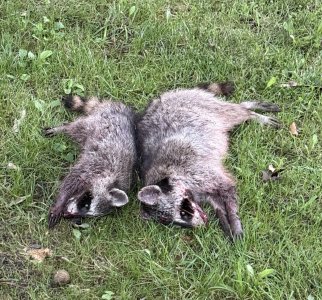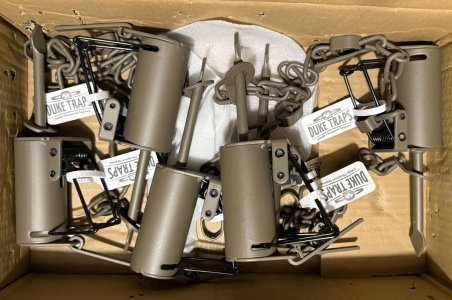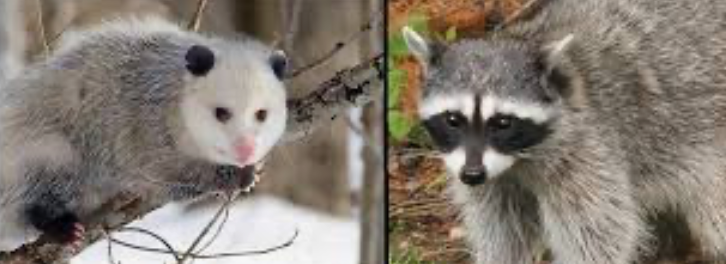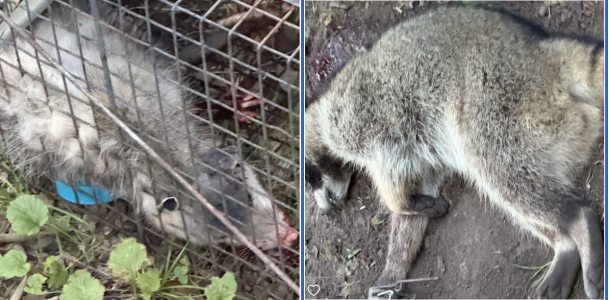Live trapping and relocating = moving the problem to someone elseI got the neighbor kid at my ohio place trapping coons and possum out.....but he (and his mom) are only on board to live/HAH cage trap and relocate. They like seeing "our" deer and squirrels but not the army of raccoons. Bittersweet advent of the last week.
-
If you are posting pictures, and they aren't posting in the correct orientation, please flush your browser cache and try again.
Edge
Safari/iOS
Chrome
You are using an out of date browser. It may not display this or other websites correctly.
You should upgrade or use an alternative browser.
You should upgrade or use an alternative browser.
Raccoon trapping
- Thread starter bueller
- Start date
Feelslikefar.
5 year old buck +
Or killing them slowly depending on the time of year.
Badgers80
5 year old buck +
Whatcha mean?Or killing them slowly depending on the time of year.
356
5 year old buck +
Killing them slowly is likely in reference to the fact that critters such as possums and raccoons can not be trapped and relocated. Almost every attempt to do so outside of a controlled relocation results in the slow death of the animal by starvation or predation. This is from a university study:Whatcha mean?
Relocating raccoons, opossums and squirrels results in a high mortality rate due to various factors. Studies show that a significant percentage of relocated mammals die within a short period, with some reports indicating mortality as high as 95%. This is primarily because these animals are adapted to a specific home range, and relocation disrupts their ability to find food, shelter, and navigate their environment.
Last edited:
Badgers80
5 year old buck +
Interesting. I wouldn’t have thought that would be the case, but I make sure it’s the fast way. Thanks for sharing.Killing the slowly is likely in reference to the fact that critters such as possums and raccoons can not be trapped and relocated. Almost every attempt to do so outside of a controlled relocation results in the slow death of the animal by starvation or predation. This is from a university study:
Relocating raccoons, opossums and squirrels results in a high mortality rate due to various factors. Studies show that a significant percentage of relocated mammals die within a short period, with some reports indicating mortality as high as 95%. This is primarily because these animals are adapted to a specific home range, and relocation disrupts their ability to find food, shelter, and navigate their environment.
Show them no mercy!My wife presented me with the perfect Father's Day Gift a few days early so I could "play" with them this weekend.
View attachment 78718
I do a lot of spring time and summer trapping. My preferred method is trap saturation over short durations - usually only three or four days. I am speaking of doing this mainly for predator reduction in reference to reduced predation of turkey nests or growing fruit.
Most recent, I set ten or a doz traps within 100 yards of my 50 tree orchard where I had pictures of coons and possums eating the fruit. In three or four trap nights, I caught eleven coons, two possums, and a skunk. I pulled most of the traps on Jun 4. I might also add there is a year round corn feeder 50 yds from the orchard

This feeder was also visited by coons. i left two traps at each end of the orchard. I rebait them once a week with a mix of corn, dry cat food, and catfish food. I have not caught anything in those two traps since jun 4. I have got pics three times since Jun 4 of a coon. I got pics of a couple possums and set a live trap and a dirt hole set with a 1 1/2 coil spring and caught two possums. I have not got a pic of a coon or possum since catching the last possum about two weeks ago.
My anecdotal observations. Animals do learn and develop a fear of the dog proof traps. That is why I like the saturate trap over short durations so hopefully, not to train the animals to avoid the traps. I have seen trap avoidance displayed in the past.
Too be honest, I expected migration of new predators into the area much quicker than has happened. It has been two months, now with ripening muscadines and fifteen trees with apples, pears, and figs. I even wonder if the presence of the few traps remaining is a deterrent.
The end of Mar, I put out nearly 30 traps over about 160 acres and caught about 30 coons and possums. This orchard location is an acre of the 160 acres.
To me, this brings up about as many questions as it answers. The big positive, two months later, there is still no coons and possums in my orchard or at the nearby feeder. I do have squirrels, which is another problem. I have two other feeders on this 160 acres that do have a coon presence. I pretty much removed them back in march, and there are now half as many as there were in march. There are also no traps in those areas - which leads me to believe the presence of traps in the orchard is still some type deterrence. I have caught as many as 80 coons and possums over four months in the past - eight or ten years ago. I used to have a dozen to as many as 18 coons in a pic at a feed location. Four is max number, now. I own 62 acres, eight miles away - untrapped - and had over 15 coons in a pic several times last fall at a feeder.
I know I have fewer coons and possums than I used to have. I know my untrapped property eight miles away has coon numbers equivalent to what I used to have. I also know I have had a few turkeys around my home ground the last five years.
These findings bring up more questions than they answer
Most recent, I set ten or a doz traps within 100 yards of my 50 tree orchard where I had pictures of coons and possums eating the fruit. In three or four trap nights, I caught eleven coons, two possums, and a skunk. I pulled most of the traps on Jun 4. I might also add there is a year round corn feeder 50 yds from the orchard

This feeder was also visited by coons. i left two traps at each end of the orchard. I rebait them once a week with a mix of corn, dry cat food, and catfish food. I have not caught anything in those two traps since jun 4. I have got pics three times since Jun 4 of a coon. I got pics of a couple possums and set a live trap and a dirt hole set with a 1 1/2 coil spring and caught two possums. I have not got a pic of a coon or possum since catching the last possum about two weeks ago.
My anecdotal observations. Animals do learn and develop a fear of the dog proof traps. That is why I like the saturate trap over short durations so hopefully, not to train the animals to avoid the traps. I have seen trap avoidance displayed in the past.
Too be honest, I expected migration of new predators into the area much quicker than has happened. It has been two months, now with ripening muscadines and fifteen trees with apples, pears, and figs. I even wonder if the presence of the few traps remaining is a deterrent.
The end of Mar, I put out nearly 30 traps over about 160 acres and caught about 30 coons and possums. This orchard location is an acre of the 160 acres.
To me, this brings up about as many questions as it answers. The big positive, two months later, there is still no coons and possums in my orchard or at the nearby feeder. I do have squirrels, which is another problem. I have two other feeders on this 160 acres that do have a coon presence. I pretty much removed them back in march, and there are now half as many as there were in march. There are also no traps in those areas - which leads me to believe the presence of traps in the orchard is still some type deterrence. I have caught as many as 80 coons and possums over four months in the past - eight or ten years ago. I used to have a dozen to as many as 18 coons in a pic at a feed location. Four is max number, now. I own 62 acres, eight miles away - untrapped - and had over 15 coons in a pic several times last fall at a feeder.
I know I have fewer coons and possums than I used to have. I know my untrapped property eight miles away has coon numbers equivalent to what I used to have. I also know I have had a few turkeys around my home ground the last five years.
These findings bring up more questions than they answer
356
5 year old buck +
I agree that that saturation/short duration works well, and believe from observation that 'coons start to recognize traps, thus avoid them. I started trapping for predator reduction after purchasing the cabin hunting property in 2012. While I primarily use dogproof traps, my arsenal includes cages and conibears. My primary goal is predator control, as our 'coon and 'possum numbers high. I didn't keep records until 2022, but generally harvested under 10 per year until this became a part of our land management plan.I do a lot of spring time and summer trapping. My preferred method is trap saturation over short durations - usually only three or four days. I am speaking of doing this mainly for predator reduction in reference to reduced predation of turkey nests or growing fruit. . .
2022-23 Season 100 'coons
2023-24 Season; 14 'coons
2024-25 Season: 21 'coons and the first picture of a hen with poults on our property.
The goal is not to eliminate the predators, but to keep the numbers in check. Hopefully the burn rotations we will be implementing will do as much or more than trapping!
I think you have seen the same thing I am seeing - that after the first few years of intensive predator removal, some maintenance trapping each year keeps the predators at a lower density.I agree that that saturation/short duration works well, and believe from observation that 'coons start to recognize traps, thus avoid them. I started trapping for predator reduction after purchasing the cabin hunting property in 2012. While I primarily use dogproof traps, my arsenal includes cages and conibears. My primary goal is predator control, as our 'coon and 'possum numbers high. I didn't keep records until 2022, but generally harvested under 10 per year until this became a part of our land management plan.
2022-23 Season 100 'coons
2023-24 Season; 14 'coons
2024-25 Season: 21 'coons and the first picture of a hen with poults on our property.
The goal is not to eliminate the predators, but to keep the numbers in check. Hopefully the burn rotations we will be implementing will do as much or more than trapping!
Tall Timbers Plantation, in their quail research, developed a predator index - a number below which they experienced quail population increase and above which they experienced a quail population decline. It was something like a 30% visitation rate to scent posts was the break point - 20% visitation rate and increasing population and 40% visitation rate a declining population. Their point was, that you dont have to remove all the predators - and you may not have to remove many. If your visitation rate if 40%, you may only have to remove four or five to lower the visitation rate to 25%.
Of course, the numbers would probably differ on every piece of ground - but point being, you dont have to get rid of all of them.
While a regular burning schedule my reduce predator density - aint nobody in my area burning - period - and I dang sure aint burning my hardwood and cedar. I will have to rely on traps - and fortunately, I enjoy it. A good excuse to get out on your property every morning for several days
Bill
Administrator
MISSOURI RACCOON & OPOSSUM SEASON IS OPEN!!
View attachment 80919
I never realized MO had an season out of forbear season for landowners. Learn something new everyday.
Last edited:
356
5 year old buck +
First two for the 2025-26 season. From a camera picture, there were five raccoons in a group that raided one dogproof and two cage traps without getting caught. However, these two did not get make it back home. I had four DPs and three cages out, and will increase the DP numbers significantly today as I set up the 2025-26 trap line.


356
5 year old buck +
The other day I observed that the two sites used for carcass recycling in the past couple of years have significantly more vegetative growth than the surrounding areas. Sadly, this includes invasive, such as autumn olive and undesirables including black locus and Osage orange. I am not sure if this is due to better soil or some other cause. However, my recycling pit this year will be in a location where I have been wanting to plant persimmons. Maybe ‘coons do have some redeeming value.I just dug my pit for the carcasses. Thinking I may get the traps out tomorrow…
Sent from my iPhone using Tapatalk



